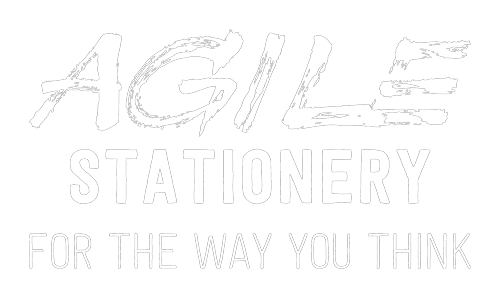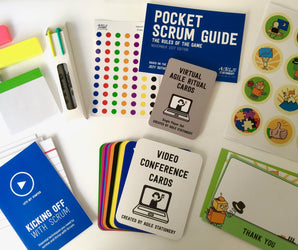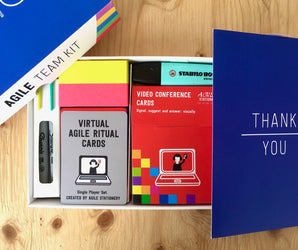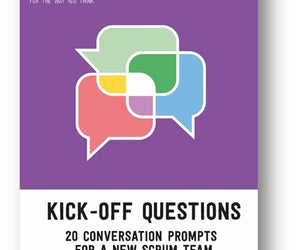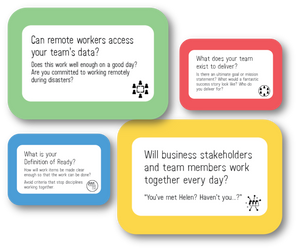Branded versions of our decks can be a great way to send a message as part of a transformation, or demonstrate leadership buy-in during any kind of cultural change. Physical artefacts feel real and can cut through the virtual hubbub to make a statement that change is here, while making people feel supported through that change.
Where might custom decks help?
Perhaps there is trouble brewing over on-call rotas, you want to try to be more predictable for stakeholders, do more for cyber security, or optimise your flow ready to commence a big project?
Custom card decks can help with complex problems, like:
- easing tension over roles and responsibilities
- rolling out estimation techniques
- gamifying or enforcing your Definition of Ready
- enable threat modelling
- conduct a quarterly health check on your software delivery needs
- continuous process improvement
All these benefits feel real and are increasingly popular with Agile Stationery customers, but how does one quantify the ROI?
Impact upon the act of communication
There are several ways our card decks contribute to cultural change, even before the cards are picked up and used. It is worth reflecting on the contribution the act of distributing branded decks makes for change leaders, quite apart from the contribution of actual gameplay:
- Embodying changes announced in other media.
- Switching from directive communication (issuing orders) to supporting with tools.
- Embodying synchronous policy communication as asynchronous content.
- Providing a means to repeat an important message.
- Making communication more colourful or playful.
The time savings for change leaders are proportionate to the scale of the organisation, and the size of the change team. A good question to ask yourself is whether you can feasibly achieve the quantity and quality of communication (including necessary repetition) without hitting time, budget or political constraints (such as taking over a group forum more than once or twice).
Impact through the act of use
Once the decks are picked up and used, they contribute in various ways according to the gameplay or design attributes of the deck:
- Reminding experts of key insights they make have forgotten, or moved on from
- Prompting consideration of a problem from additional perspectives
- Adding enabling constraints or cognitive guardrails in deep-dive workshop settings
- Speeding up regular decision making tasks
- Prioritisation
- Condensing book knowledge and allowing book knowledge to be consumed collaboratively.
- Replacing stressful confrontation with playful collaboration
The impact of these effects might be shorter in duration - reducing longer meetings to 30 minutes, for instance - but the number of individuals involved is likely to be much higher. One might also consider knock on effects such as staff retention and the impact of speeding up your wider change project.
Cost of time saved
It can be a little tricky to calculate the true cost of time for yourself and your audience. An approach I have used in practice is to take a ball-park estimate and use that as a strawman. It is usually not necessary to be perfectly accurate in order to make a decision and it is easier to adjust a worked example than start from scratch.
In our example costing, a project might save 150 engineers an hour each, and two change leaders 5 hours each. That's 160 man hours.
It is easy to imagine a project making a smaller, or a much larger impact than that in time terms. Consider the impact of Planning Poker on a single 8 person estimation session, for instance! Change leaders must estimate the real impact for their organisations.
Translating an estimate to cash terms ends up being another complex question. Simply having salary information for your audience is a tricky political issue. Weekends, paid time off, bank holidays, pensions, and hidden job taxes increase the real cost of a single working hour quite considerably. The last estimate I made for an on-payroll senior software engineer (in the summer of 2023) came to £490 per 8 hour working day.
This strawman example calculates to nearly £10,000 in direct time savings, assuming just 1 hour per engineer. This suggests most Agile Stationery clients are making back their investment before every deck has even been used. They will be in positive territory well before their overall change program has been concluded, even with the help of the deck.
Cost of development
Most of our customers delegate design, manufacture and multi-site distribution to Agile Stationery. Client involvement is limited to:
- briefing, and reviewing creative outputs
- securing budget
- digging out the brand pack
- providing shipping dates and locations
- accepting delivery
Agile Stationery provides branded versions of successful games which have already been deployed to in agile, software or cybersecurity contexts so most of our clients are not developing original gaming materials (though many are doing just that!).
Furthermore, the cost of manufacturing and design is well known and available up front. We are not the kind of company that leaves prices off the website and insists on three sales calls before sharing a scary quote! We are an accessible family business who you can get to know.
Next steps
Once you have reviewed pricing options, be sure to reach out to us for design and logistical input and to provide us your creative brief.
Discuss your custom requirement
